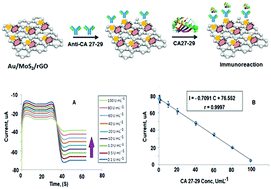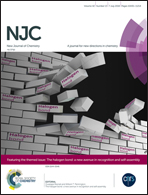New label-free ultrasensitive electrochemical immunosensor-based Au/MoS2/rGO nanocomposites for CA 27-29 breast cancer antigen detection
Abstract
Early diagnosis and clinical treatments of breast cancer provide a highly successful chance for patients to survive. Herein, the detection of CA 27-29 breast cancer antigen was conducted using a label-free ultrasensitive electrochemical immunosensor Au/MoS2/rGO nanocomposite system. The high electrochemical sensitivity of the as-prepared nanocomposites was provided as a result of the high synergistic effect between AuNPs, MoS2 and rGO. Signal amplification of the amperometric detection was evaluated by monitoring the electrocatalytic current response of hydrogen peroxide reduction through the immunoreaction between the anti-CA 27-29 and CA 27-29 antigen on the surface of the Au/MoS2/rGO nanocomposites. The immunosensor displayed an excellent specificity and high sensitivity towards the detection of CA 27-29 breast cancer antigen in human serum with low detection limits of 0.08 U mL−1. The reproducibility, stability and specificity of the suggested immunosensor were evaluated and the recorded results indicated that this type of immunosensor can play an important role in the clinical diagnosis of different types of tumor markers.



 Please wait while we load your content...
Please wait while we load your content...